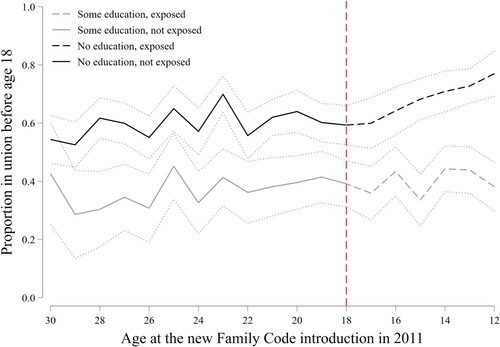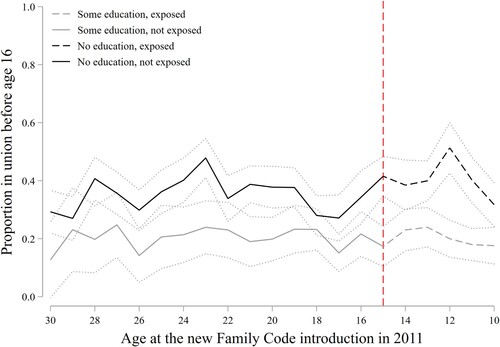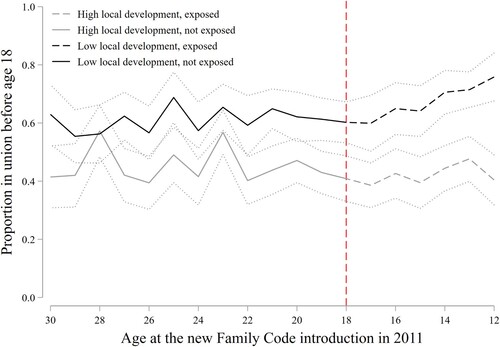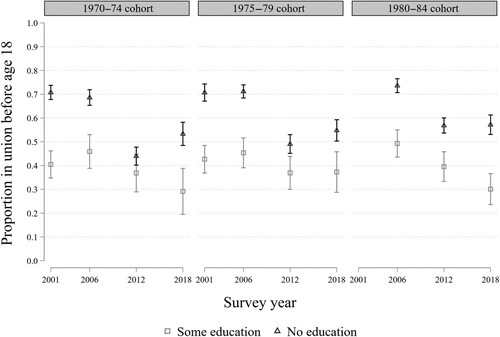Figures & data
Table 1 Details of the legal minimum age at marriage based on the 2011 Family Code and 1962 Marriage Code, Mali
Figure 1 Proportion of women who entered their first union before age 18, by their age at (and hence exposure to) the 2011 Family Code implementation: all women, Mali
Notes: Proportions are estimated using DHS weights and account for the complex survey design. Dotted lines represent 95 per cent confidence intervals around the estimates.
Source: MDHS 2018.

Table 2 Percentage of women who entered their first union before age 18, by their age at (and hence exposure to) the 2011 Family Code implementation: all women and by educational level, Mali
Figure 2 Proportion of women who entered their first union before age 18, by their age at (and hence exposure to) the 2011 Family Code implementation: women by educational level, Mali
Notes: Proportions are estimated using DHS weights and account for the complex survey design. Dotted lines represent 95 per cent confidence intervals around the estimates.
Source: As for .

Table 3 Linear probability models predicting the probability of first union before age 18, by exposure to the new 2011 Family Code and by educational level: women in Mali
Figure 3 Proportion of women who entered their first union before age 16, by their age at (and hence exposure to the 2011 Family Code implementation): women by educational level, Mali
Notes: Proportions are estimated using DHS weights and account for the complex survey design. Dotted lines represent 95 per cent confidence intervals around the estimates.
Source: As for .

Figure 4 Proportion of women who entered their first union before age 18, by their age at (and hence exposure to) the 2011 Family Code implementation, for regions that were more and less affected by the conflict: women with no education, Mali
Notes: Regions more affected by conflict (>100 deaths between 2011 and 2018) were Ségou, Tombouctou, Kidal, Mopti, and Gao. Regions less affected by conflict (<100 deaths between 2011 and 2018) were Sikasso, Kayes, and Koulikoro. Data on conflict intensity are based on the number of deaths (best estimates) from the Uppsala Conflict Data Program (Sundberg and Melander Citation2013). Proportions are estimated using DHS weights and account for the complex survey design. Dotted lines represent 95 per cent confidence intervals around the estimates.
Source: As for .

Figure 5 Proportion of women who entered their first union before age 18, by their age at (and hence exposure to) the 2011 Family Code implementation: women by level of local development, Mali
Notes: Proportions are estimated using DHS weights and account for the complex survey design. Dotted lines represent 95 per cent confidence intervals around the estimates. High local development is defined as night-time lights > 0. GPS coordinates are not available for 17 DHS clusters, so this analysis is limited to 328 unique clusters, of which half (167) report a value of zero for lights, hence the dichotomization.
Source: As for .

Figure 6 Proportion of women who entered their first union before age 18 for selected cohorts across four DHS rounds: Mali
Notes: Proportions are estimated using DHS weights and account for the complex survey design. Chart shows point estimates and 95 per cent confidence intervals. Due to differences in survey design and coverage across the survey rounds, we exclude three regions of Mali—Tombouctou, Gao, and Kidal—to ensure that the estimates across surveys are fully comparable
Source: MDHS 2001, 2006, 2012, and 2018.

